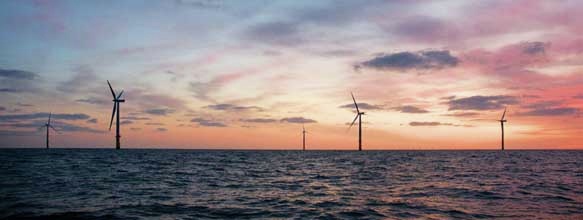News Release from windfair.net
Wind Industry Profile of
More and more records: Renewables have reached the middle of society
Investments reaches new heights
Investments in renewable energy projects went up to 329 billion US dollars worldwide last year. This is an increase of 4% over the previous year. This figure, which was recently announced by Bloomberg New Energy Finance, is all the more remarkable since various factors have to be taken into consideration: Costs of photovoltaics have fallen sharply in recent years, so a larger capacity can be installed for the same price today. In addition, the US dollar is currently quite strong, reducing the dollar value of non-dollar investment. And the European economy is not yet as strong as a few years ago, when Europe was the driving force of investments in renewables.
This role is now adopted by other regions such as China, South America and Africa. In developing countries renewable energies are added to the fuel mix early. The advantages compared to fossil fuels are independence of raw materials and the possibility of a quick assembly, in order to satisfy the countries' ever growing energy hunger.

Offshore projects are the most expensive
The most expensive projects on the list are several offshore wind farms that are built in Europe and China, including the British Race Bank (580 MW) with 2.9 billion and Galloper (336 MW) with 2.3 billion dollars. Furthermore, the German Veja Mate farm (402 MW) for 2.1 billion and two parks in China (each 300 MW) for 850 million dollars each. Most expensive project onshore is the Nafin portfolio (1,6G W) in Mexico with a value of 2.2 billion dollars.
Undisputed leader: China's appetite for energy continues
 Last year, a capacity of 62 GW in wind projects were added worldwide, of which 58 GW were built onshore, 4 GW offshore. First place was again taken by China: The construction of a record of 32,97 GW made the nation's wind energy capacity rise to 129 GW in total. The share of wind energy in the national energy mix has risen to 8.6%. However, a major problem is still the lack of grid connections for some of the new projects, even if the Chinese government is trying to get a hold of this problem. According to SeeNews, 33,9 TWh of the nearly 186.3 TWh of wind power which were fed into the Chinese grid during the last twelve months were lost.
Last year, a capacity of 62 GW in wind projects were added worldwide, of which 58 GW were built onshore, 4 GW offshore. First place was again taken by China: The construction of a record of 32,97 GW made the nation's wind energy capacity rise to 129 GW in total. The share of wind energy in the national energy mix has risen to 8.6%. However, a major problem is still the lack of grid connections for some of the new projects, even if the Chinese government is trying to get a hold of this problem. According to SeeNews, 33,9 TWh of the nearly 186.3 TWh of wind power which were fed into the Chinese grid during the last twelve months were lost.
Nevertheless, China is expected to be at the top of the list at the end of this year: According to the Chinese Ministry of Energy a further 216 GW have been approved, of which 87,07 GW are already under construction. The four-year plan for 2020 provides for another expansion of wind capacity to at least 200 GW.
Politics are ensuring a stable expansion in the US
 The United States follow with some distance, where nevertheless some records have been broken in the past year. In America, the expansion of wind power has exceeded the 70 GW mark for the first time. Wind energy was again the No. 1 source of newly installed power, adding 47%, with natural gas a distant second at 35% and solar energy at 14%.
The United States follow with some distance, where nevertheless some records have been broken in the past year. In America, the expansion of wind power has exceeded the 70 GW mark for the first time. Wind energy was again the No. 1 source of newly installed power, adding 47%, with natural gas a distant second at 35% and solar energy at 14%.
In addition, policy has provided two programs which will ensure the expansion to continue on a high level: On the one hand the PTC was extended for five years at the end of 2015. In addition, President Obama has launched his Clean Power Plan which is to provide a stable investment climate for the next few years. In the aftermath, some federal states have already adopted their own ambitious climate plans, such as California and New York, who both want to reach 50% renewable energy by the year of 2030.
Chris Brown, President for Vestas’ sales and service operations in the United States and Canada, told the Huffington Post, where the problems lie in the United States: “To effectively deploy wind energy across the U.S., we'll need 890 miles of new transmission lines by 2030.”
Germany torn between records and scaremongering
 Germany was also able to report very good results for last year: 3.535,8 MW were newly installed onshore in 2015. This ensured the second best value after 2014, where special circumstances had led to a one-time record of 4.385,9 MW. This means, construction rates last year decreased by 19%, but the German offshore industry soared to new heights and broke all records in 2015: 2.282,4 MW were installed – but catch-up effects due to new grid connections also ensured these high numbers. How the numbers of both industries will develop in the coming years is unsure, as switching to an auction system currently leads to latent scaremongering in Germany.
Germany was also able to report very good results for last year: 3.535,8 MW were newly installed onshore in 2015. This ensured the second best value after 2014, where special circumstances had led to a one-time record of 4.385,9 MW. This means, construction rates last year decreased by 19%, but the German offshore industry soared to new heights and broke all records in 2015: 2.282,4 MW were installed – but catch-up effects due to new grid connections also ensured these high numbers. How the numbers of both industries will develop in the coming years is unsure, as switching to an auction system currently leads to latent scaremongering in Germany.
Taking a look at the overall figures, Germany has a capacity of 44946.4 MW installed in wind power (41,65 GW onshore and 3,30 GW offshore) today. The onshore turbines fed 78 TWh of energy into the grid last year, offshore added another 8 TWh. In addition to a strong domestic market, the German industry can rely on exports, as usual – two thirds of the products go abroad.
Light and shadow
 In the UK wind energy continued to create happy faces. "We’ve had a bumper harvest thanks to increased deployment and superb wind speeds," said Dr. Gordon Edge from RenewableUK. 11 percent of British Energy were generated by wind turbines last year – this energy could provide 30% of Britain's households with clean energy.
In the UK wind energy continued to create happy faces. "We’ve had a bumper harvest thanks to increased deployment and superb wind speeds," said Dr. Gordon Edge from RenewableUK. 11 percent of British Energy were generated by wind turbines last year – this energy could provide 30% of Britain's households with clean energy.
However, where there is light, there is shadow: Following the decision of the government to no longer promote onshore wind, a slump in the market is feared. “It also demonstrates why the Government should continue to support wind energy, as we’re delivering on our commitment to keep Britain powered up. We can continue to increase the proportion of the nation’s electricity which we provide as we move away from fossil fuels to clean sources of power,” states Edge.
 What damage misguided policy can cause, can best be seen in Spain where not a single megawatt of wind energy was added last year. Since the government had decided to no longer promote wind energy a whole of only 1.932 MW was installed – during a period of four years. Spanish wind energy companies have only survived, because they were looking for their salvation in exporting their products: 100 percent goes abroad, mainly to South and Central America.
What damage misguided policy can cause, can best be seen in Spain where not a single megawatt of wind energy was added last year. Since the government had decided to no longer promote wind energy a whole of only 1.932 MW was installed – during a period of four years. Spanish wind energy companies have only survived, because they were looking for their salvation in exporting their products: 100 percent goes abroad, mainly to South and Central America.
Spain is already far behind in reaching the binding EU climate protection targets in the development of renewable energies by 2020. These goals can only be reached, however, if the wind industry inside Spain is re-launched. And so the Spanish wind industry looked at the climate treaty of Paris with a very special interest: Spain has signed the treaty after all.
- Author:
- Katrin Radtke
- Email:
- kr@windmesse.de

